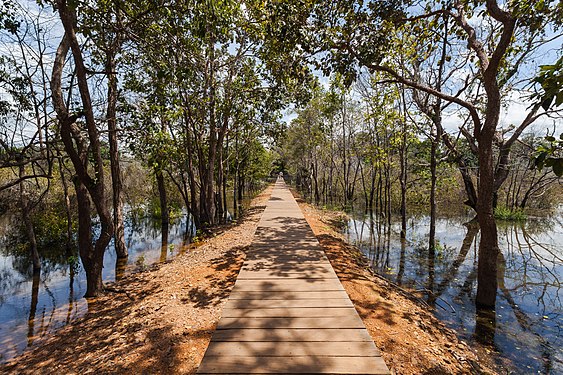
Neak Pean

| Neak Pean | |
|---|---|
 The central pond at Neak Pean | |
| Religion | |
| Affiliation | Hinduism |
| Deity | Shiva |
| Location | |
| Location | Angkor |
| Country | Cambodia |
| Geographic coordinates | 13°27′47″N 103°53′40″E / 13.46306°N 103.89444°E |
| Architecture | |
| Type | Khmer |
| Creator | Jayavarman VII |
| Completed | second half of the 12th century[1] |
Neak Pean (or Neak Poan) [2] (Khmer: ប្រាសាទនាគព័ន្ធ, "the entwined serpents") at Angkor, Cambodia is an artificial island with a Mahayana Buddhist temple on a circular island in Jayatataka Baray, which was associated with Preah Khan temple, built during the reign of King Jayavarman VII.[3]: 389 It is the "Mebon" of the Preah Khan baray (the "Jayatataka" of the inscription).[4]

Etymology
Some historians believe that Neak Pean represents Anavatapta,[5]: 174 a mythical lake in the Himalayas whose waters are thought to cure all illness.[6]: 124–125 [7] The name is derived from the sculptures of snakes (Nāga) running around the base of the temple structure, neak being the Khmer rendering of the Sanskrit naga. "They are Nanda and Upananda, two nagas traditionally associated with Lake Anavatapta."[8]

History
Neak Pean was originally designed for medical purposes (the ancients believed that going into these pools would balance the elements in the bather, thus curing disease); it is one of the many hospitals that Jayavarman VII built. It is based on the ancient Hindu belief of balance. Four connected pools represent Water, Earth, Fire and Wind. Each is connected to the central water source, the main tank, by a stone conduit "presided over by one of Four Great Animals (maha ajaneya pasu) namely Elephant, Bull, Horse, and Lion, corresponding to the north, east, south, and west quarters....The stone conduits in the little pavilions are fashioned to represent the heads of the Four Great Animals...the only exception being that on the east, which represents a human head instead of a bull's."[9] Originally, four sculptures stood on the floor of the lake. The only remaining statue is that of the horse Balaha, a form of the bodhisattva Avalokitesvara, saving sailors from the ogresses of Tamradvipa. The temple on the lake was originally dedicated to Avalokitesvara. Willetts believed that "this is Jayavarman as he would have wished to have appeared to his people"[9]

Zhou Daguan refers to Neak Pean in his visit to Angkor in the late 13th century.

Gallery
See also
References
- ^ tourism of cambodia
- ^ "Preah Neak Poan". Lonely Planet. 2016. Retrieved 11 December 2016.
- ^ Higham, C., 2014, Early Mainland Southeast Asia, Bangkok: River Books Co., Ltd., ISBN 9786167339443
- ^ Angkor
- ^ Coedès, George (1968). Walter F. Vella (ed.). The Indianized States of Southeast Asia. trans.Susan Brown Cowing. University of Hawaii Press. ISBN 978-0-8248-0368-1.
- ^ Higham, C., 2001, The Civilization of Angkor, London: Weidenfeld & Nicolson, ISBN 9781842125847
- ^ Asian Historical Architecture
- ^ Willett, William. An Angkor Roundabout. Unpublished manuscript, undated. Soon to be published online (2014) by the Southeast Asian Ceramic Society (Singapore)
- ^ a b Willetts, William.
External links
 Media related to Neak Pean at Wikimedia Commons
Media related to Neak Pean at Wikimedia Commons

See what we do next...
OR
By submitting your email or phone number, you're giving mschf permission to send you email and/or recurring marketing texts. Data rates may apply. Text stop to cancel, help for help.
Success: You're subscribed now !








